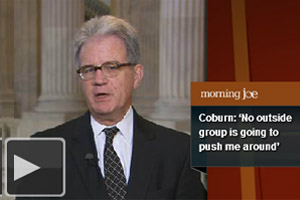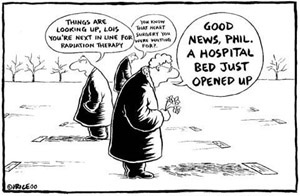 Today, U.S. Senators Tom Coburn, M.D. (R-OK), Richard Burr (R-NC), and Mike Enzi (R-WY), commented on a new Government Accountability Office (GAO) report they requested that warns the Obama Administration is failing to provide Congress and the public with timely, meaningful analysis of likely future shortages of health care providers. The report, HRSA Action Needed to Publish Timely National Supply and Demand Projections, warns that the national supply and demand projections for the health care workforce are currently based on information that is more than a decade old.
Today, U.S. Senators Tom Coburn, M.D. (R-OK), Richard Burr (R-NC), and Mike Enzi (R-WY), commented on a new Government Accountability Office (GAO) report they requested that warns the Obama Administration is failing to provide Congress and the public with timely, meaningful analysis of likely future shortages of health care providers. The report, HRSA Action Needed to Publish Timely National Supply and Demand Projections, warns that the national supply and demand projections for the health care workforce are currently based on information that is more than a decade old.
 “Today’s GAO report builds on an unfortunate theme,” Dr. Coburn said. “The federal government simply has no comprehensive federal health care workforce strategy. We have no strategy that targets precious taxpayer dollars and no strategy to strategically align workforce programs so that providers in the training pipeline are prepared to serve the patients of tomorrow. It is inexcusable that, at a time when we are facing serious projected shortages of physicians and nurses in many areas, four federal departments are running 91 programs without any coherent strategy. I look forward to working with my colleagues to change that.”
“Today’s GAO report builds on an unfortunate theme,” Dr. Coburn said. “The federal government simply has no comprehensive federal health care workforce strategy. We have no strategy that targets precious taxpayer dollars and no strategy to strategically align workforce programs so that providers in the training pipeline are prepared to serve the patients of tomorrow. It is inexcusable that, at a time when we are facing serious projected shortages of physicians and nurses in many areas, four federal departments are running 91 programs without any coherent strategy. I look forward to working with my colleagues to change that.”
 “This GAO report is deeply troubling for the future of our nation’s health care workforce,” Senator Burr said. “At a time when federal funds are extremely scarce and we face potentially significant shortages of quality doctors, nurses, and other health care providers, we need a cohesive strategy based on accurate information to ensure a robust provider pipeline. I look forward to working with my colleagues on behalf of patients and taxpayer’s to ensure that dollars are being wisely spent to adequately train medical professionals for the future.”
“This GAO report is deeply troubling for the future of our nation’s health care workforce,” Senator Burr said. “At a time when federal funds are extremely scarce and we face potentially significant shortages of quality doctors, nurses, and other health care providers, we need a cohesive strategy based on accurate information to ensure a robust provider pipeline. I look forward to working with my colleagues on behalf of patients and taxpayer’s to ensure that dollars are being wisely spent to adequately train medical professionals for the future.”
“This Administration wants government to be in charge of your health care, but it can’t even coordinate efficiently enough to give realistic projections on what our future health care workforce needs may be,” said Sen. Enzi. “Health Resources and Services Administration’s reliance on out-of-date data and failure to adjust agency priorities to address actual workforce shortages threatens to reduce access to care and exacerbate shortages in the future. I thank Senators Coburn and Burr for their leadership on this issue.”
 Senators Coburn, Burr, and Enzi sent a letter to Health Resources and Services Administration (HRSA) Director Mary Wakefield expressing their concern regarding the findings of the GAO report. In the letter, the Senators write, “GAO’s findings of HRSA’s disappointing performance are concerning, not only because of the taxpayer dollars potentially being wasted, but because we already face likely health care provider shortages in our country,”
Senators Coburn, Burr, and Enzi sent a letter to Health Resources and Services Administration (HRSA) Director Mary Wakefield expressing their concern regarding the findings of the GAO report. In the letter, the Senators write, “GAO’s findings of HRSA’s disappointing performance are concerning, not only because of the taxpayer dollars potentially being wasted, but because we already face likely health care provider shortages in our country,”
Key Findings:
• HRSA within the U.S. Department of Health and Human Services (HHS) is responsible for monitoring health care workforce adequacy. To carry out its mission, HRSA conducts and contracts for health care workforce studies. As GAO report explained, “for over a decade, government, academic, and health professional organizations have projected national shortages of health care professionals, which could adversely affect patients’ access to care.” For example, the Association of American Medical Colleges has projected that “the United States faces a shortage of more than 90,000 physicians by 2020—a number than will grow to more than 130,000 by 2025.”
• GAO’s report found that, despite spending millions of taxpayer dollars to issue contracts since 2008, under the Administration, HRSA has failed to update national supply and demand projections for the health care workforce. In fact, HRSA has missed multiple internal deadlines for issuing reports projecting the supply of and demand for various health care professionals. HRSA officials attributed the delay in publishing this report to data challenges and modeling limitations, though they did admit there are no written procedures for preparing a report for publication, which GAO says may impede the ability to deliver timely analysis.
• The analysis by GAO also reveals the lack of timely and meaningful analysis even fails to meet HRSA’s own standards, since reports may be outdated before they even become public. As GAO explains, “HRSA itself has stated that physician workforce projections should be completed at least 10 years in advance to provide enough time for policy interventions to influence the size and composition of the workforce.” However, in the case of one “report containing projections to 2020, review has been ongoing for 3 years,” which means that, “if this report were published in 2013, it would project only 7 years into the future.”
• GAO warned that if the projected shortages in the health care workforce materialize, this “could result in delays in getting care, or patients not receiving needed care.” Accordingly, GAO explained that, “in the absence of published projections, policymakers are denied the opportunity to use timely information from HRSA to inform their decisions on where to direct billions of dollars in training funds.” A previous GAO report issued at the request of Senators Coburn, Burr, and Enzi, found that four federal departments administered 91 programs in FY 2012 that supported postsecondary training or education specifically for direct care health professionals at a cost to taxpayers of $14.2 billion.
Supporting Documents
• The GAO report is available online here.
• A summary of the key findings from GAO’s report is available here.
• Letter to HRSA Director Wakefield is available here.
